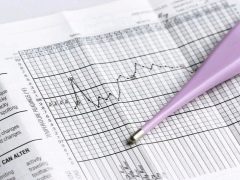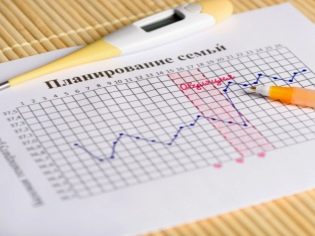Symptothermal method of recognition of fertility
Fertility issues have always worried women. Some moms are not in a hurry to become - for them there is an acute problem of contraception, which does not harm (without taking hormonal drugs, establishing a spiral, etc.). Others, on the contrary, dream of motherhood and want to know for sure the days of their own ovulation in order to conceive a child as soon as possible.
In both cases, the SMRP will come to the rescue - a symptothermal method of fertility recognition, which is desirable for all the fair sex.
What it is?
It is difficult to imagine, but in medicine the sperm was discovered in the 17th century. And in order to "get acquainted" with the female sex cell (oocyte or egg), humanity took more than half a century. The concept of ovulation, in general terms, was described only at the beginning of the last century. And from that moment on, the first primitive planning methods for the marriage calendar, which meant that In the first 10 days after menstrual bleeding, a woman cannot become pregnant.
As you understand, the method often “let down” and gave “misfires”. It quickly became apparent that there was a need to continue studying the issue of female fertility. Observing the women, physicians of the time suggested that The period of onset of fertility is preceded by certain signs and changes in the body of the weaker sex. So began to emerge the method of family planning for ovulation. But it was not accurate enough, because ovulation can shift, not occur at all, and a variety of factors can affect it: cold, stress, long-distance trip, age.
In 1938 was created temperature planning method: Doctors noticed that the basal temperature (the temperature inside the body) is sensitive to ovulation. The schedule that a woman could build on her measurements allowed her to know when ovulation started and when it ended, but, unfortunately, did not give any idea about when the fertile period actually begins, when the egg begins to mature.
It took another 30 years to combine the two methods - temperature and calendar. So there was an advanced method of determining fertility. However, its accuracy, although it was incomparably higher than all previous versions, could not suit women.
And then the Billings method was created. Dr. John Billings and his wife, Evelyn, devoted their entire lives to researching family planning. Their work helped to understand that ovulation in a woman can be only once a month, and the egg cell lives and retains the ability to conceive no more than 24 hours.
Also, spouses, scientists have established the effect of cervical mucus on the behavior of sperm. The mucus secreted by the cervix in the fertile period reduces the acidity of the vaginal environment and contributes to the advancement of sperm to the target - the egg. It is the nature of such mucus that should, according to the method of Billings, prompt the woman the time most favorable for conception.
And almost immediately after this discovery, the symptothermal method of fertility recognition was presented to the world, the author of which was a female Austrian doctor Dr. Rötzer. He absorbed the work of all predecessors. Three components were included in the SMRP:
- basal temperature indicators;
- observation of cervical secretion;
- position and condition of the cervix.
The method has opened up new opportunities for millions of women: with its help, even those of the fair sex, whose cycle is not regular, can find out with great accuracy exactly when their body is ready for conception.
It is noteworthy that the method was the first, having managed to show its effectiveness for nursing women, who in general do not have a clue after birth, after what time in the presence of breastfeeding the cycle will recover.
The method requires a large organization from a woman, but gives her the opportunity every day to know as much as possible about her own reproductive state, as well as at the early stages to identify certain gynecological and other diseases and pathologies that affect the flow of the menstrual cycle.
The method was supplemented and improved 40 years ago in Birmingham, that is why the modern version of the method is called the Birmingham modification. The symptothermal method of recognizing fertility has become even more accurate - British doctors have introduced a "double confirmation".
The women's cycle was divided into:
- infertility period preceding ovulation;
- period of fertility, when conception is the maximum possible;
- the period of post-ovulatory infertility, when the egg has already died, and conception is no longer possible for this reason.
The double signs in the English version must confirm both the beginning and the end of each of these periods.
Since 2002, Russia began teaching the Birmingham modified version of the symptothermal method. Today it is used by more than 100 countries.
The World Health Organization, which is usually quite suspicious of non-barrier and non-hormonal contraception, was forced to recognize the results of a study that showed that The accuracy of the method is up to 98%.
In addition, WHO recognized that many couples with established infertility, thanks to the SMRP, were able to conceive and carry out the baby.
How it works?
Before a woman decides to use such a method, it is better for her to attend special classes, where experienced teachers of SMRP will give the basics of the physiology of the female body, will tell in detail about the laws of the menstrual cycle, about conception. Also, a woman will be taught to listen carefully to her body and record the signs that will allow conclusions about fertility.
The fact is that a woman is fertile only for a day within one cycle. This is the very day in which her egg lives. After menstruation, the luteal phase of the cycle begins, within which the follicles mature in the ovaries. One will become dominant and will continue to grow, the rest will be suppressed by the hormonal background of the woman.
Approximately in the middle of the menstrual cycle, the follicle bursts and releases a mature ovule into the ampule of the fallopian tube. If at this moment there are live spermatozoa in the genital tract, they will be able to fertilize it (this is possible if sexual intercourse was 3-4 days before ovulation). If sexual intercourse takes place on the day of ovulation, conception is also highly probable. If sex happens for a couple of days after ovulation, then the probability of conception will be low, because the egg will die.
The symptothermal method allows you to know exactly when the fertile window begins and when it ends, which will be useful for those who are planning a pregnancy, and for those who are protected.
A woman needs to observe the characteristic signs of her fertility every day for several cycles (usually at least three) in order to understand the characteristics of her own cycle, because it can last not 28 but 30 days or even more, ovulation can not differ by constancy, etc. The signs that need to be monitored are basal temperature and the condition of the cervical mucus in conjunction with the position of the cervix. These women should be entered in a special table.
The basal temperature is measured at the sites of the blood vessels: anus, vagina, hypoglossal space. The temperature measured in the rectum and in the vagina is considered more accurate. When measuring, you should follow certain rules.
- The measurement location should not change. If a woman chose the rectum, then she should conduct all subsequent measurements only in her, without changing the place on the vagina.
- The thermometer must be constant. Different thermometers can have errors, and for accuracy of diagnostics everything is important - up to a tenth of a degree. It is better to use a mercury thermometer, it is more accurate electronic.
- Measurements should always be taken at the same time, convenient for the woman. It is impossible to measure today at 7 am, and tomorrow at 10. The measurement is taken immediately after waking up before the woman gets out of bed and goes to the toilet and bathroom. It is important that a full night’s sleep (at least 3 hours of sleep) will contribute to the awakening.
At first, many women admit, disciplining themselves can be difficult. But then measuring BT (basal temperature) becomes as natural as having to brush your teeth after waking up, going to the toilet. It is important to immediately enter the readings of the thermometer in a special schedule.
The graph, which will be obtained during the cycle, will show whether there was ovulation at all: a sharp jump in temperature to subfebrile values will report about it. So the body reacts to high levels of progesterone. The graph will show how well the ovaries work in the second part of the female cycle, whether there are enough hormones to plan a pregnancy.
About conception can speak a high (more than 37.2 degrees) basal temperature during the second phase of the cycle, that is, after ovulation.
Only once the temperature drops for one day - at the moment when the crumb is implanted in the endometrium of the uterus. After that, the temperature will become high again.
A study of the cervix is carried out with a clear understanding that the cervix does not respond to progesterone, but to estrogen, an equally important female sex hormone. Under the action of estrogen maturation of the egg occurs. Therefore cervical mucus will gradually liquefy and become more viscous and abundant. Often, women compare it to raw egg white on ovulation day.
The position of the cervix with the beginning of the fertile window is such that it rises, softens and opens slightly. The glands inside the cervical canal begin to work hard, diluting mucus. The amount of clear mucus reaches its peak immediately before ovulation. As soon as the egg leaves the follicle, that is, ovulation occurs, progesterone begins to be produced, and the cervix returns to its original state.
A woman carries out a cervical examination by herself, with clean hands, gently inserting two fingers into the vagina and placing them under the cervix, closer to the anus. All this is taught in special courses, possibly self-study. There are many detailed and accessible video tutorials on the Internet that teach how to correctly recognize and correlate the signs of fertility.
Are mistakes possible? Opinions of doctors and reviews of women
This method, as you can see, is non-calendar, not tied to the calculations on the calendar, and therefore it is more personalized, tied to the features of a particular woman. Its effectiveness is higher than just counting ovulation on the calendar.
To assess the effectiveness of the symptothermal method of recognizing fertility, the so-called Pearl index was used. This index is essentially the probability of an unplanned pregnancy. According to large-scale studies in which thousands of couples protected by this method took part, the Pearl index was only 0.3. It means that only three pairs out of a thousand, according to WHO, became pregnant, despite the use of the technique. This is what gave the doctors reason to consider the method quite effective.
In practice, alas, everything is not always the case. The opinion of obstetricians and gynecologists is almost unequivocal: an effective method will be only if the woman observes many conditions for self-diagnosis and is not mistaken with the interpretation of the results. Any mistake can cost an unplanned pregnancy, and therefore the method of contraception for all women should not be considered a reliable method. But to conceive a baby, he is quite suitable.
According to women, the method is not as complicated as it seems at first.
All measurements and fixation of all necessary indicators, indicators do not require more than 10 minutes per day. But after three months, the woman notices that the method not only gives her valuable information about her own women's health, cycle and fertility, but also promotes self-discipline.
On the teaching methods of SMRP - in the video below.



























